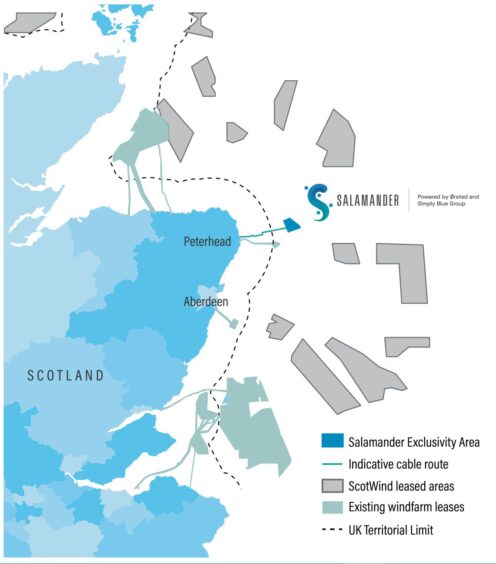The Salamander floating offshore wind farm celebrated having received planning permission in principle for its onshore works in “record time” .
The developers submitted the onshore application to Aberdeenshire Council in August last year, laying out plans for a site roughly 1.2 miles (2km) north of Peterhead for infrastructure including the substation, a 50MW battery storage facility and the onshore export cables.
A second application was also made to the Energy Consents Unit of the Scottish government for the wind farm’s energy balancing infrastructure, which includes the battery. This has been validated and is progressing through the assessment process.
Salamander project director Hugh Yendole said: “We are incredibly proud to have secured an almost-unheard-of unanimous approval in record time – only seven months after submission. We have achieved a number of significant ‘firsts’ with this consent – the first combined onshore substation and battery consent and the first consent of any of the innovation projects awarded exclusivity agreements under INTOG.
“It is also worth noting that the joint venture team that delivered this consent did so under somewhat challenging conditions, especially differentiating Salamander’s low-impact grid connection from the profusion of GW-scale infrastructure that is planned.”
 © Supplied by Big Partnership
© Supplied by Big PartnershipThe 100MW project is being developed by Ørsted, Simply Blue Group and Subsea7, and will install up to seven wind turbines on floating foundations in water 21.75 miles (35km) off Peterhead.
The project also submitted its offshore consent application in May and is awaiting approval from Scottish Ministers – this would pave the way to develop the project’s offshore components.
Salamander was a successful innovation bidder in Crown Estate Scotland’s innovation and targeted oil and gas (INTOG) leasing round.
The application envisions onshore construction starting in January 2027 at the earliest, with offshore construction expected to start in the second quarter of 2028.
It is anticipated that the Salamander Project will be commissioned and operational by the final quarter of 2029.
See Energy Voice’s interactive map charting the UK’s plans to deploy 50GW of offshore wind, including 5GW of floating offshore wind.






















